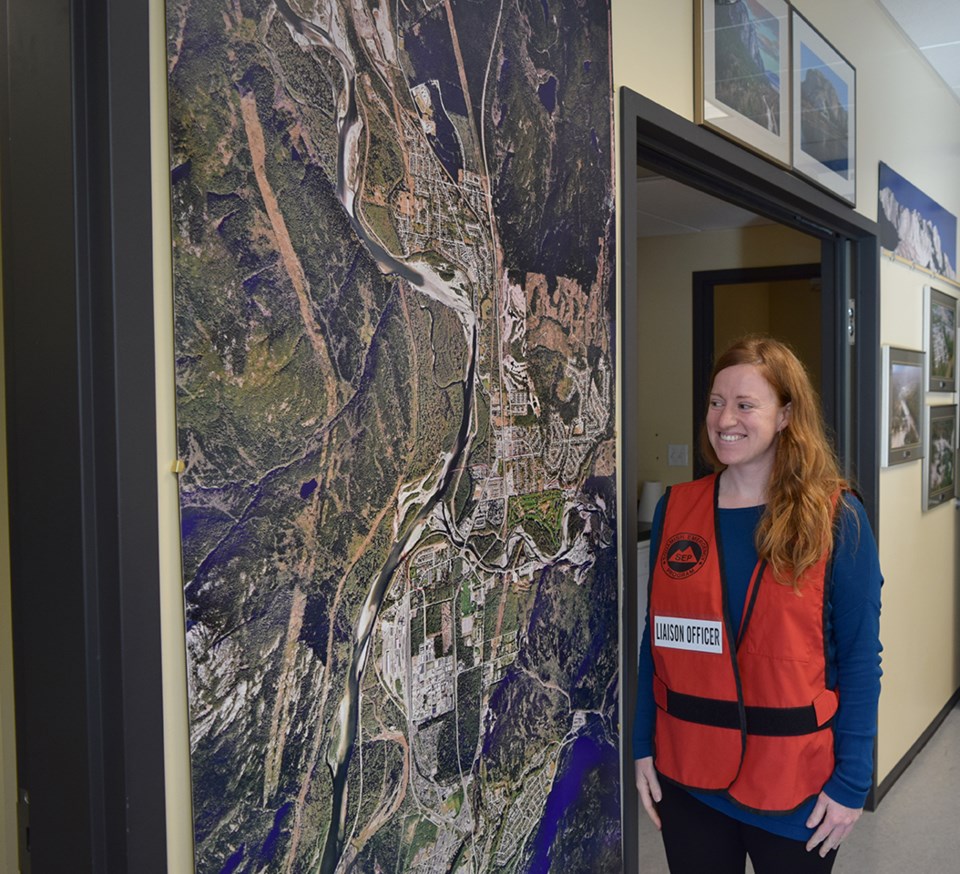The sparse room with its white walls, large whiteboard, grey oblong table and stacks of plastic containers looks like a cross between a typical office boardroom and a storage facility. In reality the room is the hub of the district’s Emergency Operations Centre (EOC), located on Finch Road at the RCMP detachment.
It is the room where district officials, prepared to handle a myriad of emergencies that could befall the region, rush to when the worst happens.
Tucked inside the seemingly innocuous grey table are computers that pop up when the table is pushed. One wall near the front door is lined with colourful vests printed with words noting the emergency role of their wearers.
The centre opened in 2005 and on average is activated twice per year, according to the district. The room is also used for a host of training exercises for groups such as the Squamish Valley Music Festival team prior to the event.
During the Squamish Terminals fire and rockslide in April, the centre was in operation.
“We are a community that has actually quite a few hazards and we have a history of things happening here, which is good and bad,” said Alexis Kraig, district emergency coordinator. “It is good in the sense that because of that people have experience so they understand what to do.”
In September council adopted the Community Risk Assessment Report, which looks at hazards that could impact Squamish and prioritizes them.
The top Squamish hazards are flooding, landslide debris flow, earthquakes or wildfires, Kraig said.
“Those are the ones we plan for the most because the likelihood and severity will impact us greatly,” she said.
The report is part of a comprehensive all hazards emergency plan, currently being created which will be presented to council in the spring, according to Kraig.
“We are building a plan where it doesn’t matter what the hazard is, we will be able to respond to it,” she said.
“The public should know that we are prepared and it is one of our priorities right now and we have the capacity to respond.”
As during the events last spring, if there were a massive natural disaster today, such as an extreme flood in Paradise Valley, the emergency centre would be activated. The core district EOC team would arrive and the centre would become an information and resource focal point, according to Kraig.
“We would be coordinating with all the different response agencies, like fire, RCMP, Ambulance, Search and Rescue,” Kraig said.
If the EOC were destroyed, Fire Hall 1 on Hospital Hill is the alternate emergency centre.
When the Squamish emergency centre activates, the provincial regional emergency centre also activates.
“We can then call upon Emergency Management B.C. for additional resources,” Kraig said.
Ultimately, Squamish residents need to ensure they are prepared to survive up to a week without assistance from the authorities, Kraig said. “We are a small town and we are going to have to rely on each other.”
In an emergency, the role of the mayor is to be out front as the spokesperson, Mayor Patricia Heintzman said. “So I use calm and reason to communicate and clearly articulate what we need citizens to do, give people good information and make sure [I’m] liaising with the media because they have a big role within an emergency situation,” she said.
Mayor and council or the mayor alone can make major policy decisions in a crisis, she said.
The mayor and council can declare a state of local emergency, which empowers the district to implement 11 drastic measures, for example, issuing an evacuation order, controlling or prohibiting travel, and use of any land or personal property.
Members of the public should turn first to the district website Squamish.ca as the first place information will be distributed in an emergency, according to Kraig.



